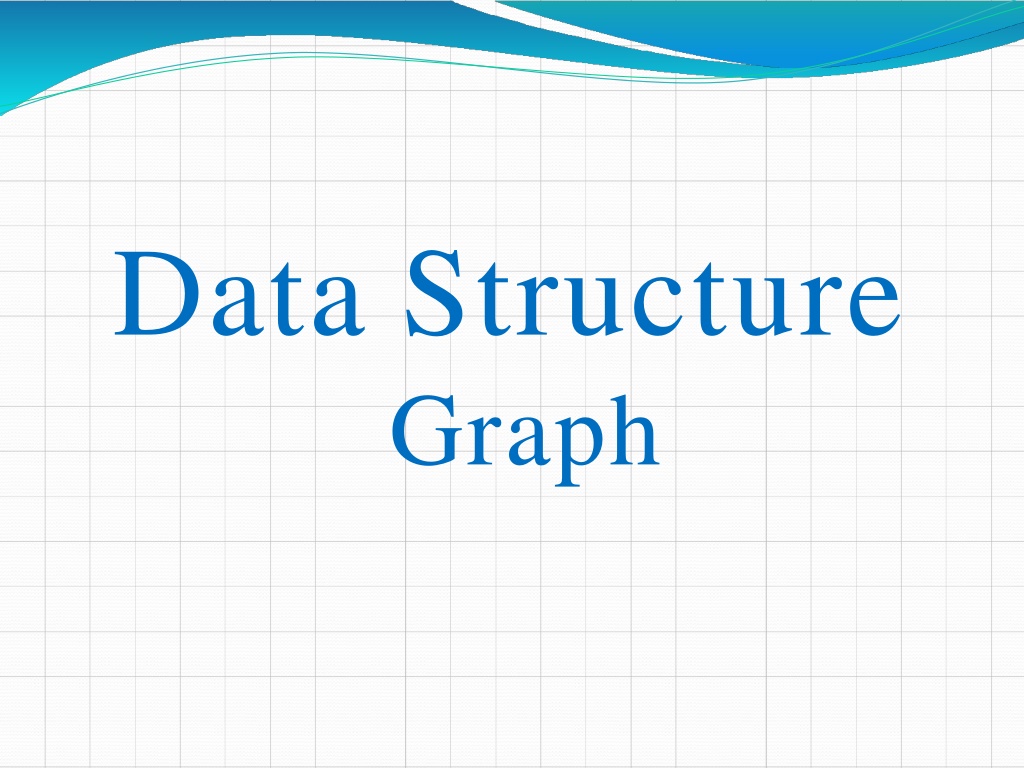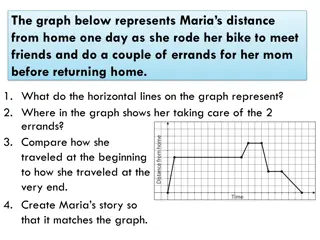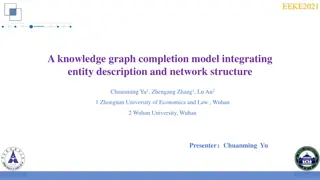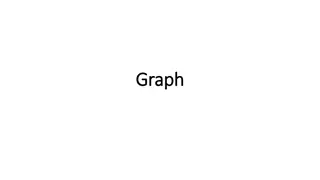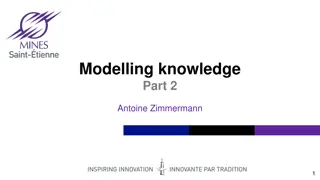Understanding Graph Data Structure: Concepts and Examples
Graph data structure is a fundamental tool in computer science, comprising nodes (vertices) connected by edges to represent relationships. This comprehensive guide covers various aspects of graphs, such as definitions, types (undirected, directed, weighted), terminology (adjacent nodes, paths, degrees), and connectivity (connected graphs, cycles). Explore examples and visual illustrations to deepen your understanding of graph theory.
Download Presentation

Please find below an Image/Link to download the presentation.
The content on the website is provided AS IS for your information and personal use only. It may not be sold, licensed, or shared on other websites without obtaining consent from the author. Download presentation by click this link. If you encounter any issues during the download, it is possible that the publisher has removed the file from their server.
E N D
Presentation Transcript
Data Structure Graph
Graphs A data structure that consists of a set of nodes (vertices) and a set of edges that relate the nodes to each other The set of edges describes relationships among the vertices . A graph G is defined as follows: G=(V,E) V(G): a finite, nonempty set of vertices E(G): a set of edges (pairs of vertices) Graph 2
Examples of Graphs V={0,1,2,3,4} E={(0,1), (1,2), (0,3), (3,0), (2,2), (4,3)} 1 When (x,y) is an edge, we say that x is adjacent to y, and y is adjacent from x. 0 2 1 is adjacent to 1. 2is not adjacent to 0. 3 is adjacent from 1. 4 3 Graph 3
Directed vs. UndirectedGraphs Undirected edge has no orientation (no arrowhead) Directed edge has an orientation (has an arrow head) Undirected graph all edges areundirected Directed graph all edges are directed u v undirectededge v u directededge Graph 4
Weightedgraph: -a graph in which each edge carries a value Graph 5
Directed graph Directed Graph Directed edge (i, j) is incident to vertex j and incident from vertex i Vertex i is adjacent to vertex j, and vertex j is adjacent from vertex i Undirectedgraph Graph 6
Graph terminology Adjacent nodes: two nodes are adjacent if they are connected by an edge 5 is adjacent to 7 7 is adjacent from Path: a sequence of vertices th5at connecttwo nodes in agraph Asimple path is a path in which all vertices, except possibly in the first and last, are different. Complete graph: a graph in which every vertex is directly connected to every othervertex Graph 7
Continued Acycle is a simple path with the same start and end vertex. The degree of vertex i is the no. of edges incident on vertex i. e.g., degree(2) = 2, degree(5) = 3, degree(3) = 1 Graph 8
Continued Undirected graphs are connected if there is a path between any two vertices Directed graphs are strongly connected if there is a path from any one vertex to any other Directed graphs are weakly connected if there is a path between any two vertices, ignoringdirection Acomplete graph has an edge between every pair of vertices Graph 9
Continued Loops: edges that connect a vertex to itself Paths: sequences of vertices p0, p1, pm such that each adjacent pair of vertices are connected by an edge Asimple path is a path in which all vertices, except possibly in the first and last, are different. Multiple Edges: two nodes may be connected by >1 edge Simple Graphs: have no loops and no multiple edges Graph 10
Graph Properties Number of Edges Undirected Graph The no. of possible pairs in an n vertex graph is n*(n-1) Since edge (u,v) is the same as edge (v,u), the number of edges in an undirected graph is n*(n- 1)/2. Graph 11
Number of Edges - DirectedGraph The no. of possible pairs in an n vertex graph is n*(n-1) Since edge (u,v) is not the same as edge (v,u), the number of edges in a directed graph is n*(n-1) Thus, the number of edges in a directed graph is n*(n-1) Graph 12
In-degree of vertex i is the number of edges incident to i(i.e., the number of incoming edges). e.g., indegree(2) = 1, indegree(8) = 0 Out-degree of vertex i is the number of edges incident fromi (i.e., the number of outgoing edges). e.g., outdegree(2) = 1, outdegree(8) =2 Graph 13
Graph Representation For graphs to be computationally useful, they have to be conveniently represented inprograms There are two computer representations of graphs: Adjacency matrix representation Adjacency lists representation Graph 14
Adjacency Matrix A square grid of boolean values If the graph contains N vertices, then the grid contains N rows and Ncolumns For two vertices numbered I and J, the element at row I and column J is true if there is an edge from I to J, otherwise false Graph 15
AdjacencyMatrix 0 1 2 3 4 0 1 2 3 4 false false false false false false false true false false true false false false false false true false false true false false true false false 1 3 2 4 0 Graph 16
AdjacencyMatrix 1 2 3 4 5 Graph 17
- Adjacency Matrix DirectedMultigraphs 2 1 4 3 A: L23 18
Adjacency ListsRepresentation Agraph of n nodes is represented by a one- dimensional array L of linked lists,where L[i] is the linked list containing all the nodes adjacent from node i. The nodes in the list L[i] are in no particular order Graph 19
Graphs: AdjacencyList Adjacency list: for each vertex v V, store a list of vertices adjacent to v Example: Adj[1] = {2,3} Adj[2] = {3} Adj[3] = {} Adj[4] = {3} Variation: can alsokeep a list of edges coming into vertex 1 2 4 3 Graph 20
Graphs: AdjacencyList How much storage isrequired? The degree of a vertex v = # incidentedges Directed graphs have in-degree,out-degree For directed graphs, # of items in adjacency lists is out-degree(v) =|E| For undirected graphs, # items in adjacency lists is degree(v) = 2|E| So: Adjacency lists take O(V+E)storage Graph 21
Implementing Graphs (a) A weighted undirected graphand (b) its adjacencylist
Thank you!!!! Graph 24
